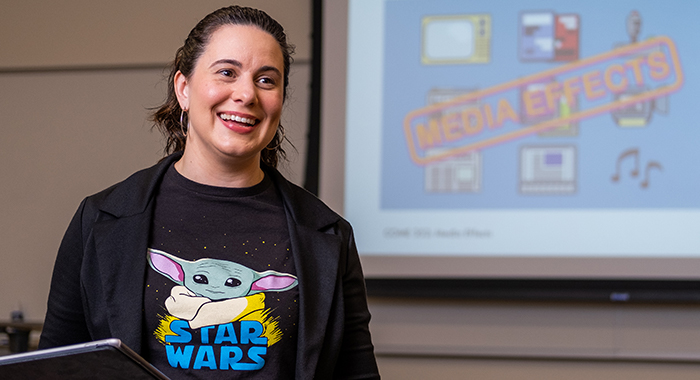A Short Course in Media Effects
Miss hitting the books? In this new occasional feature, your St. Norbert education continues as we profile a course or lecture taught by our own faculty. (And this time, there’s no final!)
The course description
COME 352 Media Effects. In this upper-level communication and media studies course, we dig into what social scientific research tells us about the uses and impacts of media. This course is beneficial for anyone because we all use media. What you’ll gain is greater media literacy, the ability to access, analyze, evaluate, create and act using all forms of communication. Media literacy empowers people to be critical thinkers and makers, effective communicators, and active citizens.
The prof
Valerie Kretz, assistant professor of communication and media studies, teaches media studies courses at all levels. She earned her M.A. from Marquette University and her Ph.D. from the University of Wisconsin-Madison. Beyond the classroom, Kretz focuses her research on entertainment media and relationships.
The classroom
South Teaching Wing 103, an active learning lab. It’s a beautiful spring afternoon and in STW 103 we enjoy an airy space with only four tables, each with their own screen. The room is full of whiteboards. After you find your assigned place, you introduce yourself to the small group who will share this learning experience with you.
#relatable?
It's possible you have:
- Phantom vibration syndrome. Have you ever picked up your phone or looked at your smartwatch because you thought it was vibrating, but it wasn’t? You’re not alone. Studies have shown that this is a prevalent phenomenon that might be more common when you’re stressed.
- Fear and loathing. Kretz remembers watching a horror movie when she was 12 years old and being scared of dolls for a long time after. One study found that most people can point to a time as a child when they watched something frightening, and those effects didn’t end when the TV show or movie did. Children may experience anxiety or sleep disruption, and fear of specific things or situations can even follow them into adulthood.
- A parasocial relationship. “Grey’s Anatomy” has a huge fan base. One of the reasons viewers are so loyal is that fans form bonds with the characters. If you have a celebrity crush, an actor or actress whose work you follow, or a favorite character, then you probably have what researchers call a parasocial relationship. (Don’t worry! These are normal byproducts of media viewing.)
- Third-person effect. It’s hard for us to imagine or admit that we’re influenced by advertising, violent video games or media stereotypes, even if we know other people are. However, if others are impacted, you’re likely not immune.
The “Terrible Influence” timeline: a brief history
It was:
- comic books in the 1950s.
- television in the 1960s and continuing.
- heavy-metal music in the 1980s.
- video games in the 1990s and continuing.
Different forms of media have been criticized for their potentially violent influence over time. In the 1960s, researchers began documenting the prevalence of violence on television. What they found was what we now call mean-world syndrome. Heavy viewers of television view the world as a meaner place. They are more likely to overestimate the incidence of crime and their own likelihood of being a victim. Since then, studies have found that media can cultivate consumers’ perceptions of the social world in all kinds of ways. For example, media use can cultivate stereotypical attitudes and behaviors.
Another pivotal study in the 1960s was the Bobo Doll Experiment. The primary finding was that children who were exposed to violent content were more likely to behave aggressively afterward than children who were not. This research prompted the development of a theory, now called social cognitive theory, which suggests that people of all ages can learn from what they observe in media. Over the years, the theory has been applied in research on many different topics such as the influence of media on risky sexual behaviors and smoking.
Assignment: Can you spot the effects of media violence? The next time someone you know plays a video game, observe their behavior during and immediately after their gaming session. Note how their behavior is different than usual.
The reading list
The textbook:
Media Effects Research: A Basic Overview
Sparks, Glenn G.
A deeper dive:
Media Effects: Advances in Theory and Research
Oliver, Mary Beth
And now, for some good news
Media-effects research tends to focus on the negative impacts of media. However, media can have positive effects, too. Media can send messages that are educational, uplifting or counter-stereotypical. Communication technology and social media can help us stay connected. Media multiplexity theory suggests that close relationships are maintained using multiple communication channels. You might only follow an acquaintance on Instagram, but with a close friend or family member you might text-message, communicate on Facebook and Snapchat, and enjoy video calls.
The final project
Using media to explain media effects research:
- Gender Roles in Disney Princess Films Podcast by Erin Vits ’22
- Parasocial Relationships with Athletes on Social Media Poster by Sydney Zima ’22
- Effects of Online Dating on Relationship Perceptions Website by Anna Lipscomb ’20
- Instagram and Body Image Infographic by Michaela Welch ’20
- How Do Cartoons Affect Children? Brochure by Megan Lange ’21
- Parasocial Relationships with YouTubers Video by Emily Buellesbach ’22
- Sports Fandom Website by Jordan Jagodinsky ’20
For extra credit
Still doubtful that you’re affected by media? Try this exercise to learn about an important media-effects concept called agenda-setting.
Looking for love? To learn more about how media influences our relationships (especially romantic ones) in both good ways and bad, check out this lecture on Media and Relationships by Valerie Kretz.
July 24, 2020












